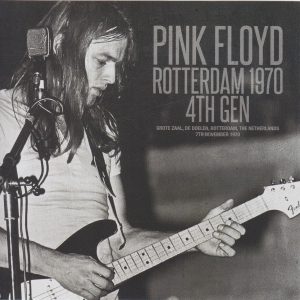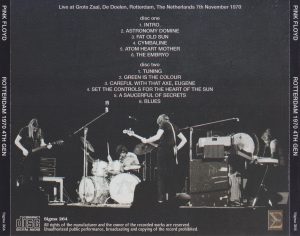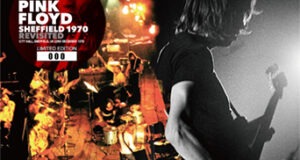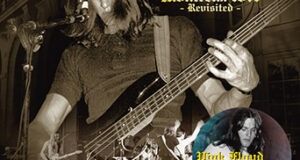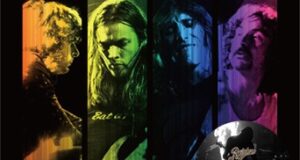Pink Floyd / Rotterdam 1970 4th Gen / 2CD / Sigma
Grote Zaal, De Doelen, Rotterdam, The Netherlands 7th November 1970
Play sample :
Click Image To Enlarge
Pink Floyd’s 1970 one-of-a-kind performance has dramatically updated the sound quality with the “4th gen” source !! !!
It is well known that the Rotterdam performance on November 7th, the second day of the European Tour that started on November 6th, 1970 with the release of the album “ATOM HEART MOTHER”, has been attracting attention for a long time due to its excellent performance expression. This point became a hot topic when it first appeared on the unofficial version as “REMERGENCE (HIGHLAND, HL 204/205)” from the old Highland label in 1998, but it was finally made into a sound source, but the sound quality was good. I think that there were many people who had the impression that it was not good enough. “GROTE ZAAL (Sigma 38)” announced by Sigma in 2009 has appeared as a source that surpasses this. The high-end sound (* probably 1st or 2nd gen), which has the same source as the Highland version but is close to the master tape, has become a big topic, and this has become a standard title in the world until now.
However, this year is October 2020. The “4th gen” source of this is the one that was gently released on the Internet with such a world standard title. As mentioned above, the source used for “GROTE ZAAL” is a good sound quality board that is presumed to be the 1st or 2nd gen, and even if the higher source of this is released, what is the value of the 4th generation source below this now? …. I opened the file with such a light feeling, and fans who were shocked by the electric shock that I rarely see in recent years are appearing all over the world. Yes, it was a shocking high-quality sound source that dismissed “GROTE ZAAL” even though it was a 4th gen. … but is there such a thing? To explain the sound quality of this source, it seems necessary to write for that reason first.
Recorder 1 is known as the only recording of the day, as far as it is currently confirmed. The world standard “GROTE ZAAL”, the old Highland version, and the 4th gen that appears this time are Recorder 1. But these three identical sources are not the sources that each follow the same line. In other words, “GROTE ZAAL” is not the figure that was in front of the sources used for the Highland board, and this 4th gen is not the figure after them. Although there are variations in generations, each is the 2nd and 4th, which was derived from the master on another occasion and followed a different route. It is strange to think that there is only one 1st gen created from the master in the first place, because if the master tape owner creates and provides 1st gen to multiple people, there are already multiple 1st gens at that point. , It is quite natural that each 1st has its own 2nd and 3rd.
When multiple people who received the 1st gen created multiple times create the 2nd gen in their respective recording environments, naturally there are the equipment they have, the grade of the tape to prepare, the recording technology and their knowledge. Due to the difference in sound quality, multiple 2nd gens will be created with considerable variation in sound quality. When it comes to the 3rd gen created from that, it should be a variety of sound images with more variation, and even with the same 2nd gen and 3rd gen, the results will be quite different. In view of this, the source used in the Highland board is about 3rd gen, which has followed a not so good recording environment, and the source used in the world standard “GROTE ZAAL” is mastered at a different opportunity from the Highland source. It can be inferred that it was a reasonably good 1st or 2nd created from. However, the 4th gen that appears this time is a high-resolution sound that slightly surpasses such world standards. The origin and background are completely different from the sources heard on each existing board, and the original master original sound was carefully inherited by the tapers who are good at recording experience and equipment knowledge “Thoroughbred 4th generation sound” It is. This is why Recorder 1’s original sound is preserved with an exceptionally miraculous freshness and resolution, and therefore its sound is far higher than the two existing editions, even if they are generations on top of each other.
What’s more, before the performance of “Atom Heart Mother”, the long song introduction MC by Roger and tuning for about 1 minute and 45 seconds, which had been completely omitted from both existing boards so far, first appeared. Of course, this is the first scene in history, and the 4th gen is a source that has taken a different path from the known route, because the appearance of the original recording, which was completely unknown, still exists as a matter of course. You can see that. On the other hand, it is also interesting that this 4th gen is missing, and there is a mysterious cut in the scene that can be confirmed normally with the existing source. This is due to the fraction of the tape used, and since this 4th gen consists of one 90-minute tape and one 60-minute tape, the tape reverse point is about every 45 minutes. It appears as a trace about every 30 minutes. However, the missing part here is the 3rd gen source left in another system (* Although the sound quality is slightly inferior to this 4th gen, the 3rd gen that follows a system different from both existing boards and this 4th gen. The sound quality is better than the existing version !!) and the show is completely restored. As a result, the 70-year Rotterdam performance, which is the longest version with the highest sound quality ever including the first appearance scene in history, was born !!!
… Therefore, this sound and the full-scale feeling of the show are shocking. On disc 1- (1), you can listen to the state and tuning of the venue before the performance and Roger’s MC as well as the existing disc, but the recording start point is the world standard “GROTE ZAAL (* Hereafter,” existing disc “” It starts about 2 seconds before “Masu)”, and it should be noted that it is a perfect recording version that you can listen to from the moment the record button is pressed. “Astronomy Domine” also appears with an order of magnitude more transparency and wall thickness than the already-sounded images. The outline of the sound is sharp, and the eyes should be naturally rounded by the amazing sound image that does not seem to be the 4th gen.
From 00:00 to 00:06 and from 9:16 to the track end, the new 3rd gen mentioned above is used for compensation, but even in this 3rd gen compensation section, the sound quality is about +2 better than the existing board. The beginning of “Fat Old Sun” and the harmonics of the bass added in the song sound even harder and more beautiful, and Dave’s singing also has a special wave of euphoria. In particular, the sound quality improvement from around 8:28 in the middle of the song is remarkable, and the fusion of a long guitar solo and Rick’s organ hits directly with an order of magnitude more vividness than the existing version. The beginning of the song from 0:00 to 0:13 is supplemented with a new 3rd gen, but since the sound quality is similar to the 4th gen, the joint is so perfect that it is hard to tell, and the tuning that starts after the end of the song is also on the day. The moderator’s announcement and sound production are included for about 3 minutes and 30 seconds or more, which is also the transparency and vividness that dismisses the existing board.
“Cymbaline” is also different from the existing board where the midrange is crushed and dark and muddy, and the brightness and vividness unique to thoroughbred sauce are breathing in the tone and sound. Only at 5:07, there is a gap in the sound that is not on the existing board for a moment, but this seems to be a trace (* reverse point of the tape) when the 4th gen was transferred to the 90-minute tape. The sound restarts from the point where it was rewound for about 2 seconds, so if you listen back and forth again, you can see that there is no missing scene. The tuning of about 1 minute and 45 seconds that develops after the end of the song and the introduction of the long song of the next song “Atom Heart Mother” by Roger are the first appearance scenes in history. This seamless listening response is a considerable advantage, as each of the existing sources has been cut almost entirely here. The “Atom Heart Mother” has a sound omission that does not exist in the same place on the existing board in 3 seconds from 2:12 to 15, which is also a feature peculiar to 4th gen (* This is a generational process It’s a trace that occurred at some point). However, in terms of sound quality, there is also an overwhelming upper feeling here, and the tuning that exceeds 3 minutes and 30 seconds after the performance has appeared with exceptional vividness and close range from the existing sounds. On the other hand, in “The Embryo”, the recorded sound of the 4th gen is missing in about 20 seconds from 1:25 to 46, so this is also an adjustment + treatment of the new 3rd gen with a waveform of 1/1000. However, this is also a perfect patch that you will not notice unless you write that it is supplemented like this. In addition, the tape is twisted from 10:07 to 13, but the overwhelming master original sound power that exudes instantly erases the discomfort.
“Careful With That Ax, Eugene” is a scene where you can see the difference in source, and the symptom that the sound suddenly becomes louder at 7:28 on the existing board (* Dolby effect ON / OFF, etc., something at this position at the time of copying, etc. There is no trace of tampering with the switch). The sound image unique to 4th gen, whose volume is maintained correctly throughout the song, will awaken unexperienced excitement. In “Set The Controls For The Heart Of The Sun”, the bass rhythms different from usual from around 9:09, and the guitar gives a powerful effect to this, which is the best listening point of the day. Appearing in clarity, you should be surprised that the sharpness of the mid to low range and the way the core is inserted are completely different. In “A Saucerful Of Secrets”, the spread of the sound to the left and right is wider than the existing board, so the turbidity of the bass range is greatly reduced, and the rhythm pattern of the drums entering from 5:54 seems to be different from usual. Will arrive even more beautifully. The guide vocal section in the final stage is also unusual for this period, and the appearance of singing a lot of 2 choruses is developed with a clear and clear sound, in contrast to the cloudy and dark sound so far. In this way, the recording of the 4th gen ends at 20:03 with the cheers after the end of the song, and the tuning and “Blues” after the end of the song will be the exclusive place of the new 3rd gen, but in fact this is also a big listening point. Especially in the middle stage, the performance peculiar to this day, which is unusually hard development, is a sound image that goes above the existing board, and it is certain that you will be amazed at its ability to the end.
Even so, this sound quality is good. The notation is certainly 4th gen, but if you try to avoid it with the negative image of this number, it is an excellent sound that you will regret for a lifetime. Please enjoy the vividness of the pure pedigree sound that does not fade at all even after generations, not the sound that has increased in miscellaneous taste as it branches. This is Sigma’s latest work, in which time passes in a blink of an eye while being fascinated by the overwhelming upper feeling of the sound!
★ Mainly the “4th Gen New Source”, which was discovered this time and has excellent sound quality, and edited to the longest version by compensating for the missing parts (with inferior sound quality) with “3rd Gen”. Definitely the best and definitive version of the 1970 Rotterdam performance!
★ 1 minute 45 seconds tuning before the performance of “Atom Heart Mother” and a long song introduction by Roger MC first appeared in history (recorded in 4th Gen)
ピンク・フロイド1970年屈指の名演が、何と” 4th gen “ソースで飛躍的に音質更新!! 既発とは別ルートを辿った下位世代のソースが上位世代のソースを駆逐する音源下克上が勃発です!!
アルバム『ATOM HEART MOTHER』発表に伴って1970年11月6日から始まった欧州ツアーの2日目、11月7日のロッテルダム公演は演奏表現の秀逸さで古くから注目されていた事は有名です。これが1998年に旧Highlandレーベルから『REMERGENCE (HIGHLAND, HL 204/205)』として非公式盤初登場となった時もその点が話題になりましたが、やっと音盤化された貴重音源ながらも音質的にはイマイチの印象を持たれた方が多かったと思います。これを上回るソースとして登場したのが当Sigmaから2009年に発表された『GROTE ZAAL (Sigma 38)』。Highland盤と同一ソースながらマスターテープに近い上位サウンド(※ 恐らく1stか2nd gen)が大きな話題となり、これが現在まで世界基準タイトルとして定番化しています。
ところが今年2020年の10月。そんな世界基準タイトルを尻目にそっとネット公開されたのがこれの” 4th gen “ソース。前述の通り『GROTE ZAAL』使用ソースは1stか2nd genと推察される良音質盤で、これの上位ソースが公開されるならともかく、これを下回る第4世代のソースに今更何の値打ちがあるのか…。そんな軽い気持ちでファイルを開き、近年稀に見る電撃大ショックを受けたファンが世界中で続出。そう、それは4th genなのに『GROTE ZAAL』を一蹴する衝撃の高音質ソースだったからです。…でもそんな事ってあるのでしょうか?本ソースの音の良さを説明するにはまずその理由から書く必要がありそうです。
現在確認されている限り、この日の録音はRecorder 1が唯一のものとして知られています。世界基準の『GROTE ZAAL』も旧Highland盤も、そして今回登場する4th genもRecorder 1。でもこの同一の3ソースは、それぞれが同じ線上を辿ったソースではありません。つまり『GROTE ZAAL』はHighland盤使用ソースの前にあった姿ではなく、今回の4th genはそれらの後の姿でもないという事です。世代にバラつきはあるものの、それぞれがマスターから別の機会に派生して別のルートを辿った2ndであり、4thである訳です。そもそもマスターから作成された1st genが1つしか無いと考えるのもおかしな話で、マスターテープ所有者が複数人に1st genを作成・提供した場合もうその時点で複数の1st genが存在する訳ですから、それぞれの1stにそれぞれの2ndや3rdがあるのはごく自然な流れです。
その、複数個作成された1st genを受け取った複数人がそれぞれの録音環境で2nd genを作成すると、当然ながらそこには各人が持っている機材、用意するテープのグレード、録音技術とその知識の差によって音質にかなりバラつきの出た2nd genが複数個作成される事になります。そこから作成された3rd genになると更にバラつきの出た多様な音像となっている筈で、同じ2nd gen、3rd genでもその結果が随分違うものが存在する事になります。これに鑑みるとHighland盤で使用されたソースはさほど良くない録音環境を辿ってしまった3rd genくらいが妥当なところであり、世界基準『GROTE ZAAL』の使用ソースはHighlandソースとは別の機会にマスターから作成された、そこそこ良好な1stか2ndだったと推察出来るのです。しかし今回登場する4th genはそんな世界基準を軽く凌駕する高解像サウンド。各既発盤で聴けたソースとは出自と経緯が完全に異なっており、録音経験と機材知識に長けたテーパー達によってオリジナルのマスター原音が大切に継承された” サラブレッドな第4世代の音 “なのです。格の違う奇跡的な鮮度と解像度でRecorder 1の原音が保たれているのはこの為で、それ故に2つの既発盤より世代は重ねていてもそのサウンドは遥かな高みにあるのです。
しかも!! 「Atom Heart Mother」の演奏前にはこれまでの両既発盤で丸ごと抜け落ちていた約1分45秒間ほどのチューニングとロジャーによる長めの曲紹介MCが初降臨。勿論これは史上初登場のシーンであり、全く知られていなかったオリジナル録音の姿がこうして当たり前に現存している点からも、この4th genが既知のルートとは異なる道程を辿ったソースである事が判ると思います。反面、この4th genならではの欠落が生じているのも面白いところで、既発ソースでは普通に確認出来るシーンで不思議なカットが入っているのです。この要因となっているのは使用されたテープの分数で、この4th genは90分テープと60分テープが各1本ずつで構成されている事から、そのテープ・リバース点が約45分毎と約30分毎に痕跡として出ているのです。ただここで欠落している箇所は更に別系統で残された3rd genソース(※ 今回の4th genより若干音質は劣るものの、両既発盤ならびに本4th genとも異なる系統を辿った3rd gen。これも既発盤より音質が良い!!)を使用してショウを完全復元。結果、史上初登場シーンを含む過去最高音質にして最長版となる70年ロッテルダム公演が誕生したのです!!!
…それ故にこのサウンドとショウのフル尺感は衝撃的。ディスク1-(1)には既発盤同様に開演前の場内の様子とチューニング、そしてロジャーのMCが聴けますが、録音スタート箇所が世界基準『GROTE ZAAL (※ 以降、” 既発盤 “とします)』より約2秒ほど手前から始まっており、まさに録音ボタンが押された瞬間から聴けるパーフェクト収録版となっている事をまず特記しておきましょう。「Astronomy Domine」も既発音像とは桁違いの透明度と肉厚さで登場。音の輪郭も鋭く、とても4th genとは思えない驚異的な音像に自然と眼が丸くなる筈です。
00:00~00:06、及び9:16~トラックエンドまでは前述の新規3rd genで補填していますが、この3rd gen補填区間ですら既発盤より+2ほど音質が良いのです。「Fat Old Sun」も出だしや曲中で添えられるベースのハーモニクスが更に硬質で美麗に響き、デイヴの歌唱もその陶酔感が特上の波動で届きます。特に楽曲中盤8:28付近からの音質向上感は目覚ましく、長いギター・ソロとリックのオルガンによる融合が既発盤とは桁違いの鮮やかさで直撃してくるのです。楽曲冒頭0:00~0:13は新規3rd genで補填していますが、4th genと音の質が似ているのでその繋ぎ目はまず判らないほど完璧ですし、終曲後に入るチューニングも当日の司会者のアナウンスや音出しの様子が約3分30秒間以上も入っており、これも既発盤を一蹴する透明さと鮮やかさです。
「Cymbaline」も中音域が潰れて暗く濁っていた既発盤とは異なり、音色と響きにサラブレッド・ソースならではの明るさと鮮烈さが息衝いています。唯一5:07で一瞬だけ既発盤には無い音の空白があるのですが、これは90分テープにトランスファーされた4th gen作成時の痕跡(※ テープのリバース点)と思われます。2秒ほど巻き戻された地点から音がリ・スタートするので、前後を聴き直すとシーンの欠落は生じていない事も確認出来るでしょう。終曲後に展開する約1分45秒間ほどのチューニングとロジャーによる次曲「Atom Heart Mother」の長めの曲紹介は史上初登場シーンです。既発の各ソースではここがほぼ丸ごとカットされていたため、このシームレスな聴き応えはかなりのアドヴァンテージ。その「Atom Heart Mother」は2:12~15の3秒間で既発盤の同箇所には存在しない音抜けがあり、これも4th gen特有の特徴となっています(※ これは世代を重ねたどの時点かで生じた痕跡でしょう)。しかし音質面ではここも圧倒的なアッパー感があり、終演後に入る3分30秒間超えのチューニングも既発サウンドとは別格の鮮やかさと至近距離で登場です。一方「The Embryo」は1:25~46迄の約20秒間で4th genの収録音が抜けているため、これも新規3rd genを波形1/1000でアジャスト+トリートメント。しかしこれもこの様に補填していると書かなければまず気付かない完璧なパッチです。また10:07~13ではテープよれが生じているのですが、これも滲み出る圧倒的なマスター原音力で瞬時にその違和感が掻き消されます。
「Careful With That Axe, Eugene」はソースの違いが判るシーンとして、既発盤の7:28で生じていた突然音が大きくなる症状(※ ドルビー効果のON / OFF等、コピー時にこの位置で何らかのスイッチをいじった痕跡)が存在しません。曲を通して音量が正しく維持された4th genならではの音像が未体験の興奮を呼び覚ますでしょう。「Set The Controls For The Heart Of The Sun」は9:09付近からベースが通常とは異なるリズムを刻み、これにギターが強烈なエフェクトを効かせてゆくというこの日ならではの聴きどころが過去最高の明瞭さで登場、中~低音域の鮮明さと芯の入り方が全く違っている事に驚かれる筈です。「A Saucerful Of Secrets」は左右への響きの拡がりが既発盤よりワイドに出ている事で低音域の混濁感が大幅に薄れ、5:54から入るドラムもそのリズムパターンが通常と異なる様子が一層綺麗に届きます。終盤のガイドボーカル区間もこの時期としては珍しく2コーラス分たっぷり歌い上げる様子がこれまでの曇って暗いサウンドとは対照的に、明瞭で抜けの良い音で展開しているのです。こうして4th genの録音は終曲後の歓声と共に20:03で終了、その先にある終曲後のチューニングと「Blues」は新規3rd genの独壇場となりますが、実はこれも大きな聴きどころ。特に中盤、珍しくハードな展開をするこの日特有のパフォーマンスが既発盤の上をゆく音像となっており、その実力に最後まで目を見張ること確実です。
それにしてもこの音質の良さ。表記上は確かに4th genですが、この数字のマイナスイメージで敬遠などしようものなら生涯後悔すること確実な秀逸サウンドです。枝分かれしてゆくうちに雑味が増した音ではなく、世代を経ても全く色褪せない純血統サウンドの鮮烈さを是非本作でお愉しみ下さい。そのサウンドの圧倒的なアッパー感に心酔しているうち、瞬く間に時が過ぎてしまうSigmaの最新作です!!
★今回発掘された、段違いに音質が優れている「4th Genニューソース」をメインに、欠落箇所を(音質の劣る)「3rd Genで」補填することで最長版へ編集。間違いなく1970年ロッテルダム公演の最良版にして決定版!
★「Atom Heart Mother」の演奏前の1分45秒のチューニングとロジャーによる長めの曲紹介MCは史上初登場(4th Genに収録されてました。)
Disc 1 (78:09)
1. Intro ★0:18 – 最後まで補填
2. Astronomy Domine ★0:00 – 0:06 補填 / ★9:16 – 最後まで補填
3. Fat Old Sun ★0:00 – 0:13 補填
4. Cymbaline
5. Atom Heart Mother
6. The Embryo ★1:25 – 1:46 補填
Disc 2 (66:21)
1. Tuning
2. Green Is The Colour
3. Careful With That Axe, Eugene
4. Set The Controls For The Heart Of The Sun ★1:33 – 2:39 補填 / ★14:22 – 最後まで補填
5. A Saucerful Of Secrets ★0:00 – 0:41 補填 / ★20:03 – 最後まで補填
6. Blues ★全部補填
Sigma 264
 GiGinJapan Artwork of Japanese CDs (mostly)
GiGinJapan Artwork of Japanese CDs (mostly) 